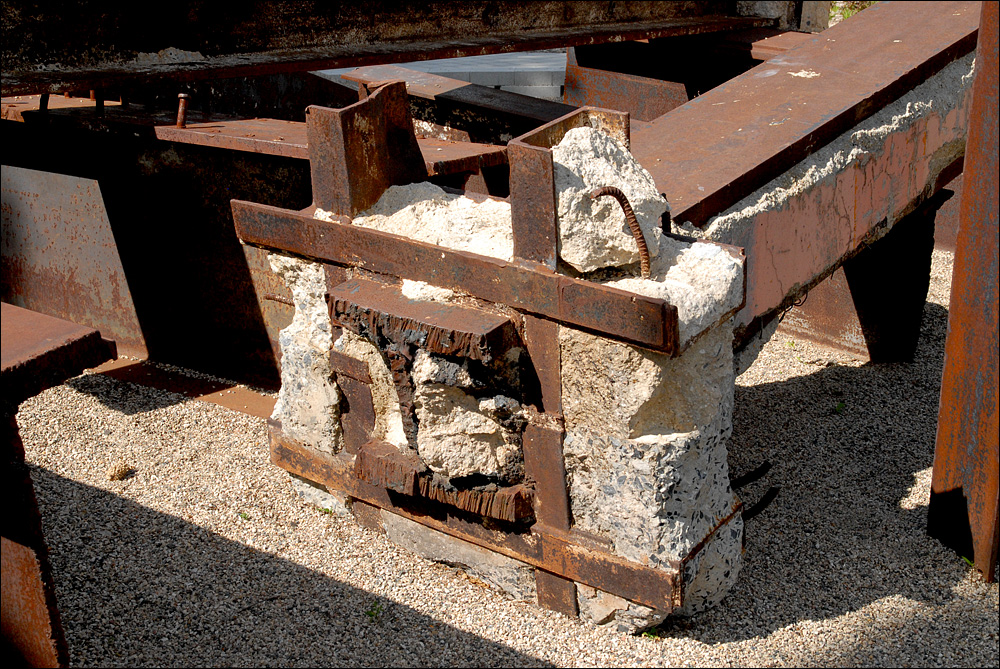The following slide has been part of Richard Gage's 9/11 Truth presentation for several years, at least since 2008 when it showed up in a version of 9/11: Blueprint for Truth video (which is basically Gage giving the extended version of his slideshow).
It's supposedly the spectrum of a sample of slag taken from a cut steel beam that's currently in the International Peace Garden on the US/Canadian border.
He says this is the chemical signature of thermite. He also claims that the irregular and messy nature of the cut on the beam shows it was not Oxy-acetylene, contrasting it with a "clean" cut on a different beam.
Here's a closer look.
Gage said, in a recent podcast,
In order to better understand what the X-EDS spectrum actually meant, I did a bit of reading.So there's other beams that have slag on the end in these sculptures that are round the world, this one in Manitoba, Canada. [Stephen Jones] does X-Ray florescence [and] finds iron, sulfur, potassium, manganese. These ingredients, well guess what those are, those are the ingredients of thermite. Particularly with the manganese, the aluminum and iron content here in addition to other stuff.
https://en.wikipedia.org/wiki/Energy-dispersive_X-ray_spectroscopy
While looking as some X-EDS results on Google Images, I happened to notice one that looked familiar:EDS can be used to determine which chemical elements are present in a sample, and can be used to estimate their relative abundance. The accuracy of this quantitative analysis of sample composition is affected by various factors. Many elements will have overlapping X-ray emission peaks (e.g., Ti Kβ and V Kα, Mn Kβ and Fe Kα). .
https://www.mccrone.com/mm/semeds-analysis-problem-solving-food-industry/
Fe is iron, Mn is Manganese, Si is Silicon, Al is Aluminum. Notice Gage said the important parts of the signature were Mn, Al, and Fe. Let's compare those peaks with this sample of carbon steel rust. I've scaled it vertically to match the background levels.The iron to manganese ratio is consistent with carbon steel. ... The orange/brown coloration of the aggregates suggests that they are carbon steel rust particulates.
It's a perfect match for those elements! The only different is that the large peak on the right is labeled "Fe" on the rust particle, but Fe Mn on the slag. Yet the peak itself is nearly identical. Then I remembered what it said in Wikipedia:
Manganese and Iron have overlapping peaks! Specifically the K-beta line for manganese overlaps the K-alpha line for iron. Most elements have two measurable lines on the spectrum, alpha and beta. The alpha line is the stronger line. This large combined peak is the K-alpha of iron (6.402) and the K-beta of Manganese (6.490) . This means that the amount that Mn contributes to that Fe/Mn peak is less than the tiny K-alpha Mn (5.897) peak to the left of it.Many elements will have overlapping X-ray emission peaks (e.g., Ti Kβ and V Kα, Mn Kβ and Fe Kα).
How much less? Look at an X-EDS spectrum of manganese without iron:
Mn K-beta about 1/8th the size of Mn K-alpha. Meaning there's basically no Mn in that second peak in the slag chart.
Which means the "signature" of Mn, Al, and Fe from the slag sample matches the carbon steel rust sample exactly.
Which means it's not thermite residue.
It's slag for the column being cut after the collapse, possibly with a thermal lance which explains the irregular cut (which isn't even that irregular without the forced perspective in that photo.
But what about the other elements mentioned on the slide?
S is sulfur, K is potassium Ca is calcium. Let's look at those, keep in mind the alpha and beta peaks.
The sulfur peak is barely there, it's actually less in the slag sample than in the rust sample. The Potassium (k) K-alpha peak is similar, and the even smaller K-beta peak is obscured by the Calcium K-alpha peak. They totally misrepresented this analysis.
Of course this proves nothing about the collapses of the towers other than that particular column was not cut with thermite. It does however prove that Architects and Engineers for 9/11 Truth don't really understand X-EDS spectra analysis. They have used this faulty interpretation to make a false claim over and over for ten years.
If they can get something as simple as this wrong, then we should probably assume they've got quite a few other things wrong too.
Last edited:



